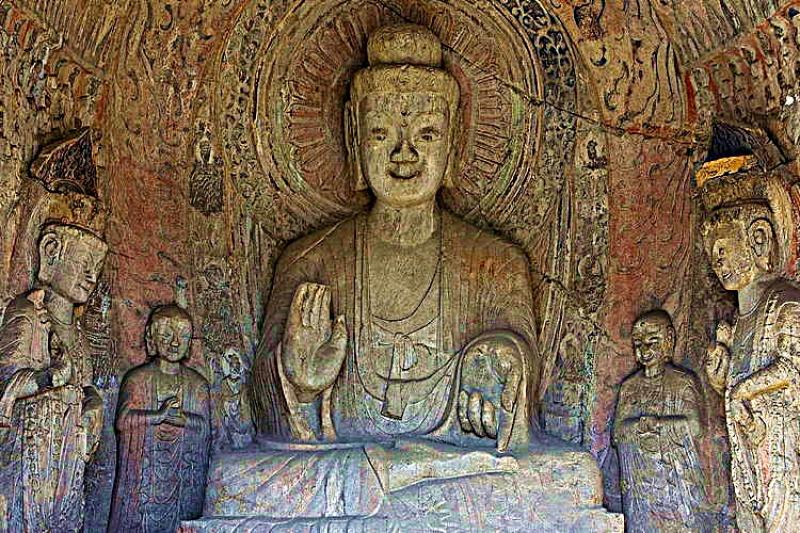Photo Essay - The World Heritage Longmen Grottoes

Photo Essay - The World Heritage Longmen Grottoes
About 11 years ago I travelled to Luoyang to see a number of attractions, the Longmen Grottoes, the Geological Park, The White Horse Temple, King Park and the Yellow River. For now, I am posting information about and photos of Longmen Grottoes, and I will post articles about the others in due course. The first time I ever had seen anything carved out of the side of a mountain was in Petra, Jordan, and more recently I saw (and have just posted a photo essay of) The Giant Buddha of Leshan.

Longmen Grottoes (China) © Vincent Ko Hon Chiu
That photo is not mine, but is from the UNESCO web site, and below I provide some of their information, but you can click their link for a more complete description, and their photos.
UNESCO WEB SITE: http://whc.unesco.org/en/list/1003
Longmen Grottoes
The grottoes and niches of Longmen contain the largest and most impressive collection of Chinese art of the late Northern Wei and Tang Dynasties (316-907). These works, entirely devoted to the Buddhist religion, represent the high point of Chinese stone carving.
The Longmen Grottoes, located on bothsides of the Yi River to the south of the ancient capital of Luoyang, Henan province, comprise more than 2,300 caves and niches carved into the steep limestone cliffs over a 1km long stretch. These contain almost 110,000 Buddhist stone statues, more than 60 stupas and 2,800 inscriptions carved on steles. Luoyang was the capital during the late Northern Wei Dynasty and early Tang Dynasty, and the most intensive period of carving dates from the end of the 5th century to the mid-8th century. The earliest caves to be carved in the late 5th and early 6 t h centuries in the West Hill cliffs include Guyangdong and the Three Binyang Caves, all containing large Buddha figures. Yaofangdong Cave contains 140 inscription recording treatments for various diseases and illnesses. Work on the sculpture in this cave continued over a 150 year period, illustrating changes in artistic style. The sculptural styles discovered in the Buddhist caves of the Tang Dynasty in the 7th and 8th centuries, particularly the giant sculptures in the Fengxiansi Cave are the most fully representative examples of the Royal Cave Temples’ art, which has been imitated by artists from various regions. The two sculptural art styles, the earlier “Central China Style” and the later “Great Tang Style” had great influence within the country and throughout the world, and have made important contributions to the development of the sculptural arts in other Asian countries.
Following are some of the photos I took while there:
1. It was necessary to park a fair distance away, and walk over a couple of bridges.

2. And then we walked past this abandoned (most likely centuries ago) stone house.

3. Many of those small caves had Buddhas in them.

4. Across the river was an occupied monastery.

5. Now we start to see the bigger Buddhas.

6.

7.

More to come on Luoyang - one of the ancient Dynasty Capitals of China.
Tags
Who is online
95 visitors

Luoyang is also where the Annual Peony Festival is held - the Peony is the National Flower of China.
Another great essay Buzz. Do you know why they are called the Longmen Grottoes?
It's early here and I haven't had my coffee yet so it's quite possible that I missed the explanation.
Apparently it got its name from one of the mountains from which the caves were carved out.
From Wikipedia:
"Shan" is the Chinese word for mountain, so in English it would be "Mount Longmen".
Don't ask me where the mountain got its name, or what it means....I have no idea.
Very nice and interesting. I enjoy seeing your adopted home through your eyes.
It's never too late for a new adventure, Gary.
"We live in a wonderful world that is full of beauty, charm and adventure. There is no end to the adventures that we can have if only we seek them with our eyes open.
(Jawaharlal Nehru - the first Prime Minister of India)
Places like this are just Amazing. Imagine the man hours that go into creating this many works of art in stone. Obviously a place like this represents the life's work of hundreds of Craftsmen. I wonder who paid them or if it was the Monks who built this place to draw worshippers ?
One doesn't think in "man-hours" with these kinds of projects. I think man-decades would be closer. In fact it must have taken lifetimes.
And the hits just keep on coming!
Wonderful post, Buzz.
Lots more still to come.
wow..and all we have is Mt. Rushmore.
Unbelievable what humans used to accomplish.
Been to Petra and Mt. Rushmore.
Would love to visit these grottoes.
Great Snaps Buzz.
Enoch.
Amazing photo essay, thanks for sharing it here
Wow!!! Was I ever surprised to see this pop up on the Home (Front) Page. I posted it 3 years ago. How did you find it? I have posted photo essays of places that I've visited in China for for the past 15 years - on the Creative Arts group and the Discovery Group (you have to delve back into their archives), and the Home (Front) Page Photography and Art Forum.